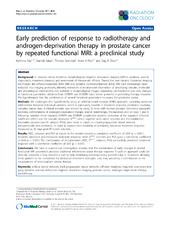Early prediction of response to radiotherapy and androgen-deprivation therapy in prostate cancer by repeated functional MRI: a preclinical study
Peer reviewed, Journal article
Published version
Permanent lenke
https://hdl.handle.net/1956/5549Utgivelsesdato
2011-06-08Metadata
Vis full innførselSamlinger
Originalversjon
https://doi.org/10.1186/1748-717x-6-65Sammendrag
Background: In modern cancer medicine, morphological magnetic resonance imaging (MRI) is routinely used in diagnostics, treatment planning and assessment of therapeutic efficacy. During the past decade, functional imaging techniques like diffusion-weighted (DW) MRI and dynamic contrast-enhanced (DCE) MRI have increasingly been included into imaging protocols, allowing extraction of intratumoral information of underlying vascular, molecular and physiological mechanisms, not available in morphological images. Separately, pre-treatment and early changes in functional parameters obtained from DWMRI and DCEMRI have shown potential in predicting therapy response. We hypothesized that the combination of several functional parameters increased the predictive power. Methods: We challenged this hypothesis by using an artificial neural network (ANN) approach, exploiting nonlinear relationships between individual variables, which is particularly suitable in treatment response prediction involving complex cancer data. A clinical scenario was elicited by using 32 mice with human prostate carcinoma xenografts receiving combinations of androgen-deprivation therapy and/or radiotherapy. Pre-radiation and on days 1 and 9 following radiation three repeated DWMRI and DCEMRI acquisitions enabled derivation of the apparent diffusion coefficient (ADC) and the vascular biomarker Ktrans, which together with tumor volumes and the established biomarker prostate-specific antigen (PSA), were used as inputs to a back propagation neural network, independently and combined, in order to explore their feasibility of predicting individual treatment response measured as 30 days post-RT tumor volumes. Results: ADC, volumes and PSA as inputs to the model revealed a correlation coefficient of 0.54 (p < 0.001) between predicted and measured treatment response, while Ktrans, volumes and PSA gave a correlation coefficient of 0.66 (p < 0.001). The combination of all parameters (ADC, Ktrans, volumes, PSA) successfully predicted treatment response with a correlation coefficient of 0.85 (p < 0.001). Conclusions: We have in a preclinical investigation showed that the combination of early changes in several functional MRI parameters provides additional information about therapy response. If such an approach could be clinically validated, it may become a tool to help identifying non-responding patients early in treatment, allowing these patients to be considered for alternative treatment strategies, and, thus, providing a contribution to the development of individualized cancer therapy.

